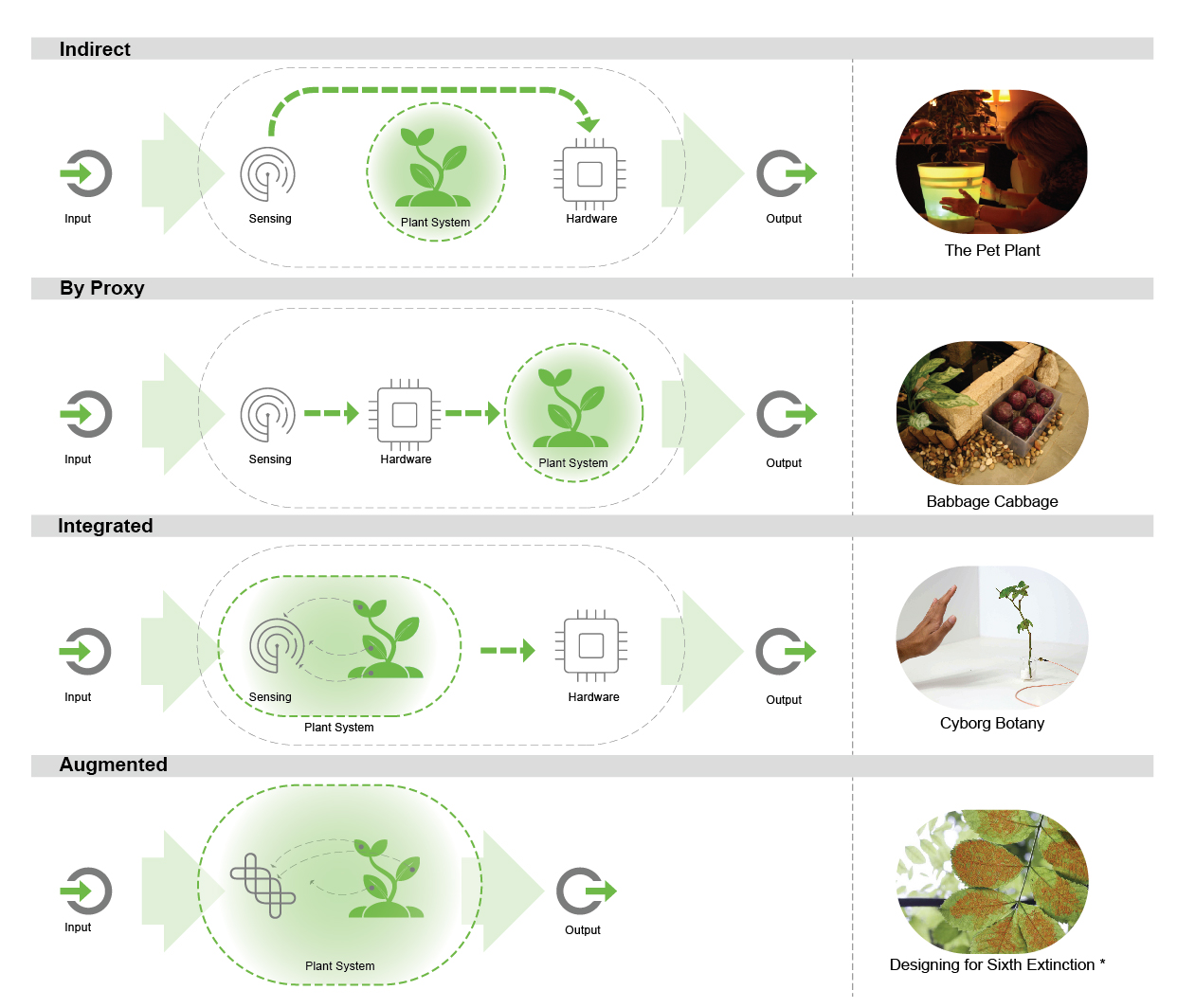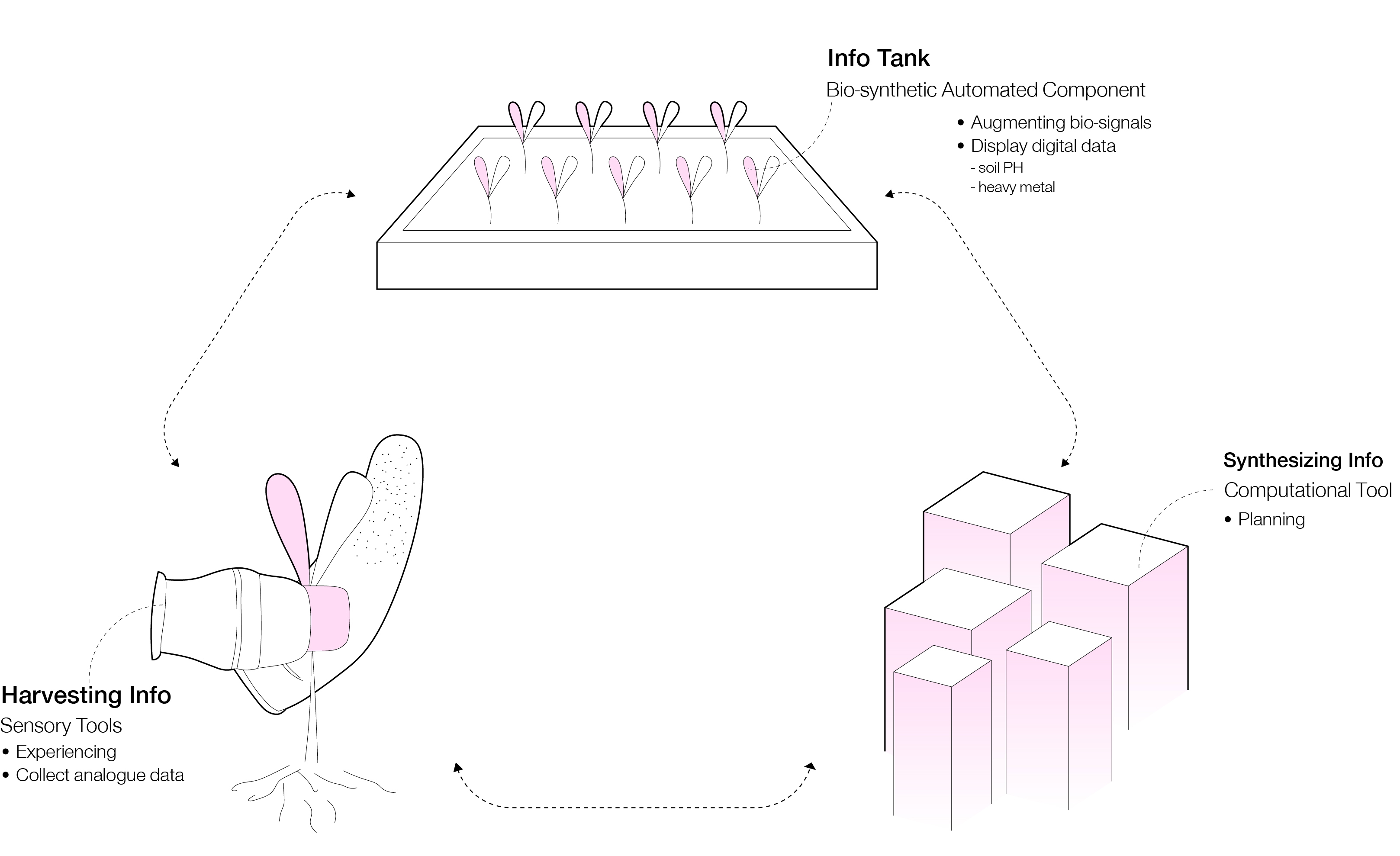Plant Cyborg (In Progress)
MS in Computational Design | Thesis (Adivising Committee: Lining Yao, Daragh Byrne)
Carnegie Mellon University
Tags: Shape-Changing Interface, Small-scale Automation, Robotics, Sensory Experience, Interaction Design
MS in Computational Design | Thesis (Adivising Committee: Lining Yao, Daragh Byrne)
Carnegie Mellon University
Tags: Shape-Changing Interface, Small-scale Automation, Robotics, Sensory Experience, Interaction Design
The burgeoning of technology and the rapid development of cities have increased the amount of time people spend in man-made environments. In recent years, the trend of having a lifestyle that is closer with nature has become prevalent. Online influencers that advocate lifestyles as such attract millions followers around the world. Especially under a pandemic setting, people have found stronger inherent eagerness to have more contact with nature.

Interaction with plants has been known for being therapeutic, recreational and rehabilitating for people.
Well known theories of the restorative influence nature has on humans include the Attention Restoration Theory of Kaplan and Kaplan and the psycho-evolutionary model by Ulrich. Nature gives people an opportunity to be away from routine activities and thoughts. It attracts involuntary attention that requires no effort. It also gives people the idea that you are in a whole other world that has a meaning and is well-ordered. It was also suggested that nature has patterns that reduce arousal, and therefore, reduce our feelings of stress, especially in a modern world, where we are constantly bombarded with so much noise, movement and visual complexity.
On the other hand, most of us probably don’t know that much about plants due to all kinds of gaps, such as difference in timescale, sensing capabilities, communication pathways, etc. It takes experts years to observe them before they have better understanding of various biomarkers. Plants can have as many as 15 different kinds of sensings, way more than human beings. Yet not all of them are known to us. They are extremely sensitive to their environment. Although the sensing happens rapidly within the plants, they are usually inconspicuous to humans due to the fact that plants express changes really slowly.
Well known theories of the restorative influence nature has on humans include the Attention Restoration Theory of Kaplan and Kaplan and the psycho-evolutionary model by Ulrich. Nature gives people an opportunity to be away from routine activities and thoughts. It attracts involuntary attention that requires no effort. It also gives people the idea that you are in a whole other world that has a meaning and is well-ordered. It was also suggested that nature has patterns that reduce arousal, and therefore, reduce our feelings of stress, especially in a modern world, where we are constantly bombarded with so much noise, movement and visual complexity.
On the other hand, most of us probably don’t know that much about plants due to all kinds of gaps, such as difference in timescale, sensing capabilities, communication pathways, etc. It takes experts years to observe them before they have better understanding of various biomarkers. Plants can have as many as 15 different kinds of sensings, way more than human beings. Yet not all of them are known to us. They are extremely sensitive to their environment. Although the sensing happens rapidly within the plants, they are usually inconspicuous to humans due to the fact that plants express changes really slowly.



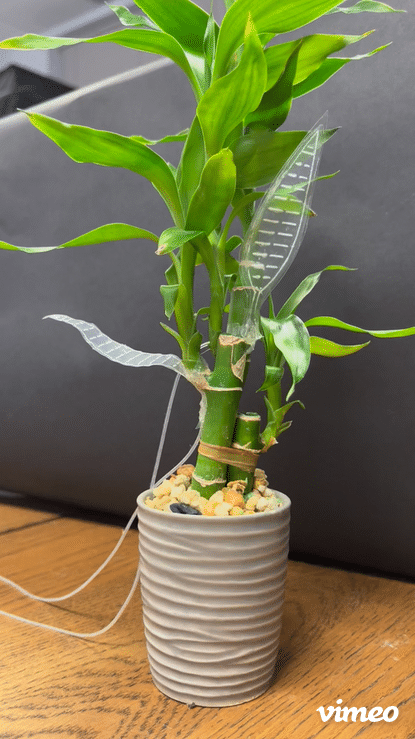
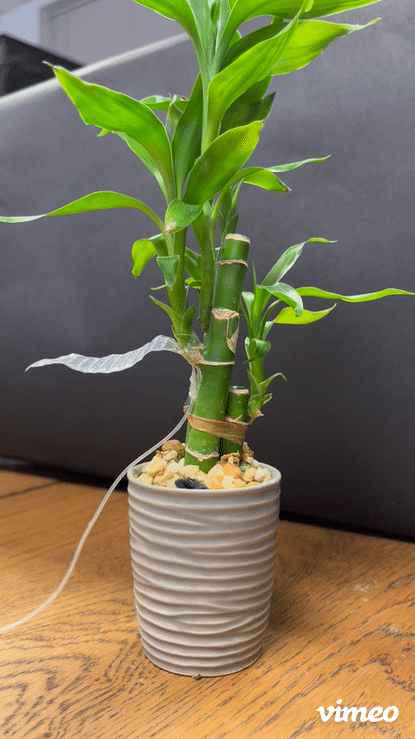
With the advancement of sciences and technology, there has been a rising trend in exploring human plant interactions. There are a lot of existing precedents that try to explore this direction through aspects such as biological, ethical, artistic, etc. Let’s take a look at some examples.
One of the earlier examples, which is also well known, is Botanicus Interacticus led by Ivan Poupyrev in 2012. The project used Swept Frequency Capacitive Sensing technology, which was new at that time. The plants get excited at multiple frequencies while being touched. Machine-learning techniques were used to recognize gestures for higher precision.
Another recent example is Cyborg Botany by Harpreet Sareen and his coworkers. In the study, conductive wires were grown inside the plants through PEDOT-S solution. The in-vivo wire then was connected with external hardwares and the plants become motion sensors. Also, nanoparticles were used in their other study for detecting chemicals in water through plants. Fluorescence readings were conducted to show the concentration of certain chemicals after the sensors were excited.
In both examples,the designers try to turn plants into sensors or interfaces. As you can tell, there is a huge focus on human experience. Plants don’t necessarily benefit from these processes. On the other side of the coin, new technologies that enhance plants’ growth, monitor their health, such as biosensors, tissue-adhered electrodes are explored for precision farming and smart agriculture. They are usually used in professional fields and not accessible to most people.
One of the earlier examples, which is also well known, is Botanicus Interacticus led by Ivan Poupyrev in 2012. The project used Swept Frequency Capacitive Sensing technology, which was new at that time. The plants get excited at multiple frequencies while being touched. Machine-learning techniques were used to recognize gestures for higher precision.
Another recent example is Cyborg Botany by Harpreet Sareen and his coworkers. In the study, conductive wires were grown inside the plants through PEDOT-S solution. The in-vivo wire then was connected with external hardwares and the plants become motion sensors. Also, nanoparticles were used in their other study for detecting chemicals in water through plants. Fluorescence readings were conducted to show the concentration of certain chemicals after the sensors were excited.
In both examples,the designers try to turn plants into sensors or interfaces. As you can tell, there is a huge focus on human experience. Plants don’t necessarily benefit from these processes. On the other side of the coin, new technologies that enhance plants’ growth, monitor their health, such as biosensors, tissue-adhered electrodes are explored for precision farming and smart agriculture. They are usually used in professional fields and not accessible to most people.
Furthermore, not all technologies that are used for enhancing interaction between human and plants facilitate people’s engagement as were expected. Projects such as the telegarden, which is a community garden that allows users to plant and tend seeds in a remote garden by controlling a robotic arm through a web-based interface, as well as, companies such as Grow Squares, who advocates that their products are able to let people check on their garden from anywhere, in fact, may discourage active presence in the garden. Consequently, the user may neglect or never learn important cues about the health of plants according to studies led by Tad Hirsch.
Other design concerns include very little to no mobility of the devices, as was pointed out by Leonardo Angelini and his co-authors in their project “EmotiPlant: Human-Plant Interaction for Older Adults”. They said, “The need to attach the system to the power outlet could limit the freedom of placing the plant according to the needs not only of the user, but also of the plant.”
Moreover, little of plants’ inherent sensing abilities are leveraged in most human-plant interaction cases. Most projects use plants as conductive materials and connect them with other electronic devices. As mentioned before, plants have powerful sensing systems that can be extended or augmented in more diverse ways.
In vivo approaches, such as sticking plants in chemical culture, has been proved to be harmful to the vitality of plants. Insertions, on the other hand, are usually invasive. And the impacts those methodologies have on plants’ physiology and morphology yet need to be further investigated.
Hereby, in my thesis, I would like to speculate the design of systematic prototypes to achieve two goals. One is to help people better understand plants by making their various biosignals seen to us. The other is to encourage people’s presence and engagement in natural contexts, thus developing a sensibility for understanding the environment and drawing experiential value from the practice.
Inspired by artistic projects by Jane Tingley and Hannah Brown, I looked at possibilities to design prosthetic parts for plants. On one hand, they can help to restore the original look of plants that might be damaged in natural events such as storms. On the other hand, they could be encasing various digital technologies as well as serving as an interface for displaying biosignals in a more expressive way. More importantly, by attaching itself to the original plant, the prosthetic interface invite people into a natural context, contrasting to a man-made or lab setting as were in previous examples.
Moreover, little of plants’ inherent sensing abilities are leveraged in most human-plant interaction cases. Most projects use plants as conductive materials and connect them with other electronic devices. As mentioned before, plants have powerful sensing systems that can be extended or augmented in more diverse ways.
In vivo approaches, such as sticking plants in chemical culture, has been proved to be harmful to the vitality of plants. Insertions, on the other hand, are usually invasive. And the impacts those methodologies have on plants’ physiology and morphology yet need to be further investigated.
Hereby, in my thesis, I would like to speculate the design of systematic prototypes to achieve two goals. One is to help people better understand plants by making their various biosignals seen to us. The other is to encourage people’s presence and engagement in natural contexts, thus developing a sensibility for understanding the environment and drawing experiential value from the practice.
Inspired by artistic projects by Jane Tingley and Hannah Brown, I looked at possibilities to design prosthetic parts for plants. On one hand, they can help to restore the original look of plants that might be damaged in natural events such as storms. On the other hand, they could be encasing various digital technologies as well as serving as an interface for displaying biosignals in a more expressive way. More importantly, by attaching itself to the original plant, the prosthetic interface invite people into a natural context, contrasting to a man-made or lab setting as were in previous examples.

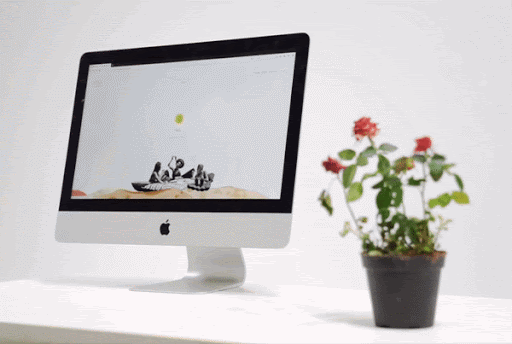
Borrowing ideas from agriculture and horticulture, such as implanting or bonsai, the prosthetic part is expected to become a seamlessly connected part of the original plant. The prosthetic will be sharing the sensing system with the original plants, displaying the plant’s real-time response to the environment or synchronizing its own growth with it. With different textures, or exaggerated motions, or other pathways of communication such as luminescent or acoustic, the prosthetic part is an important human-visible interface for bio-information output, thus leading to a better understanding of the status of the plant and the environment. On the other hand, the prosthetic part can also intake people’s interaction patterns with the plants. With processed data, it can learn people’s habit or preferences, thus better indulging them with nature.
Different parts of plants will be examined to determine the biological and aesthetic potential to work with a prosthetic part. Parts with different morphological features such as rhizomes, fast moving leaves, adventitious roots can be considered.
As well as hollow culms, such as bamboos, horsetails, can be considered as a potential structure to encase external devices. Or flowers, such as dandelions with a unique dispersal system, can be studied as a disassemblage model. Non-vascular plants, such as moss, can be considered as a form of attachment as well.
Knowing there are a lot of biological challenges with the vision, several stepping stones are considered as transitional models that might be informative for the ultimate prototyping.
One example is tree wrapping, which is a traditional concept in agricultural or horticultural practices. In japan, people use elaborate lacework of rice-straw ropes to support the branches from a central pole or trunk to prevent branch from snapping due to snow weight during winter time. It was also believed that the wrappings can attract pests and at the season’s end, they would be removed and tossed away together with the wrapping, though which was claimed by later studies to be removing more beneficial insects instead.
Borrowing the concept, if the tree wrapping can be replaced by different materials or implemented through new technologies, they can serve similar purpose as the prosthetic prototype.
As well as hollow culms, such as bamboos, horsetails, can be considered as a potential structure to encase external devices. Or flowers, such as dandelions with a unique dispersal system, can be studied as a disassemblage model. Non-vascular plants, such as moss, can be considered as a form of attachment as well.
Knowing there are a lot of biological challenges with the vision, several stepping stones are considered as transitional models that might be informative for the ultimate prototyping.
One example is tree wrapping, which is a traditional concept in agricultural or horticultural practices. In japan, people use elaborate lacework of rice-straw ropes to support the branches from a central pole or trunk to prevent branch from snapping due to snow weight during winter time. It was also believed that the wrappings can attract pests and at the season’s end, they would be removed and tossed away together with the wrapping, though which was claimed by later studies to be removing more beneficial insects instead.
Borrowing the concept, if the tree wrapping can be replaced by different materials or implemented through new technologies, they can serve similar purpose as the prosthetic prototype.

